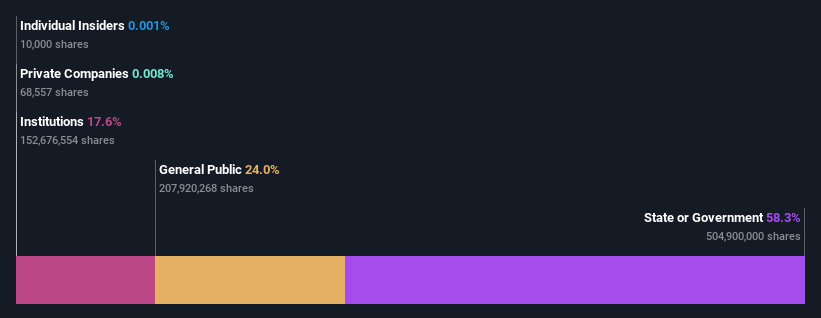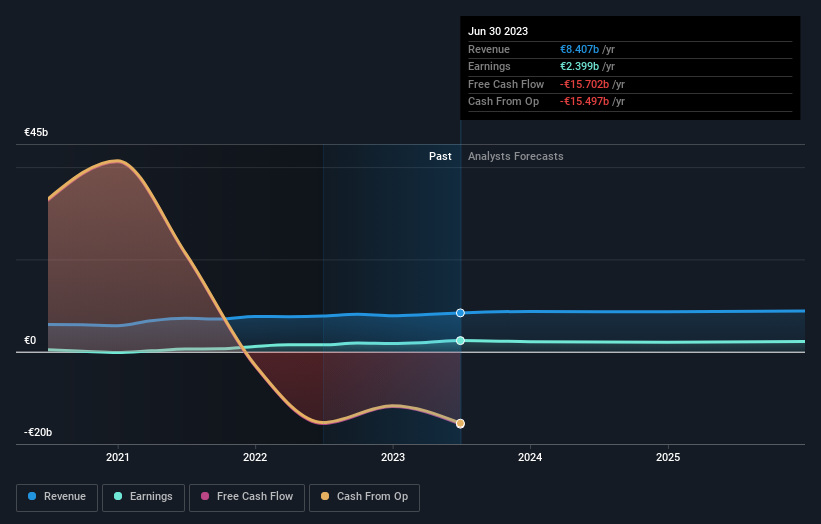While individual investors own 24% of ABN AMRO Bank N.V. (AMS:ABN), state or government are its largest shareholders with 58% ownership
Key Insights
Significant control over ABN AMRO Bank by state or government implies that the general public has more power to influence management and governance-related decisions
NL Financial Investments owns 52% of the company
To get a sense of who is truly in control of ABN AMRO Bank N.V. (AMS:ABN), it is important to understand the ownership structure of the business. We can see that state or government own the lion's share in the company with 58% ownership. Put another way, the group faces the maximum upside potential (or downside risk).
Individual investors, on the other hand, account for 24% of the company's stockholders.
In the chart below, we zoom in on the different ownership groups of ABN AMRO Bank.
Check out our latest analysis for ABN AMRO Bank
What Does The Institutional Ownership Tell Us About ABN AMRO Bank?
Institutions typically measure themselves against a benchmark when reporting to their own investors, so they often become more enthusiastic about a stock once it's included in a major index. We would expect most companies to have some institutions on the register, especially if they are growing.
ABN AMRO Bank already has institutions on the share registry. Indeed, they own a respectable stake in the company. This suggests some credibility amongst professional investors. But we can't rely on that fact alone since institutions make bad investments sometimes, just like everyone does. It is not uncommon to see a big share price drop if two large institutional investors try to sell out of a stock at the same time. So it is worth checking the past earnings trajectory of ABN AMRO Bank, (below). Of course, keep in mind that there are other factors to consider, too.
ABN AMRO Bank is not owned by hedge funds. NL Financial Investments is currently the company's largest shareholder with 52% of shares outstanding. This implies that they have majority interest control of the future of the company. For context, the second largest shareholder holds about 6.6% of the shares outstanding, followed by an ownership of 2.7% by the third-largest shareholder.
While it makes sense to study institutional ownership data for a company, it also makes sense to study analyst sentiments to know which way the wind is blowing. There are plenty of analysts covering the stock, so it might be worth seeing what they are forecasting, too.
Insider Ownership Of ABN AMRO Bank
While the precise definition of an insider can be subjective, almost everyone considers board members to be insiders. Management ultimately answers to the board. However, it is not uncommon for managers to be executive board members, especially if they are a founder or the CEO.
I generally consider insider ownership to be a good thing. However, on some occasions it makes it more difficult for other shareholders to hold the board accountable for decisions.
Our information suggests that ABN AMRO Bank N.V. insiders own under 1% of the company. As it is a large company, we'd only expect insiders to own a small percentage of it. But it's worth noting that they own €138k worth of shares. It is good to see board members owning shares, but it might be worth checking if those insiders have been buying.
General Public Ownership
The general public-- including retail investors -- own 24% stake in the company, and hence can't easily be ignored. While this size of ownership may not be enough to sway a policy decision in their favour, they can still make a collective impact on company policies.
Next Steps:
While it is well worth considering the different groups that own a company, there are other factors that are even more important. Be aware that ABN AMRO Bank is showing 2 warning signs in our investment analysis , and 1 of those makes us a bit uncomfortable...
Ultimately the future is most important. You can access this free report on analyst forecasts for the company.
NB: Figures in this article are calculated using data from the last twelve months, which refer to the 12-month period ending on the last date of the month the financial statement is dated. This may not be consistent with full year annual report figures.
Have feedback on this article? Concerned about the content? Get in touch with us directly. Alternatively, email editorial-team (at) simplywallst.com.
This article by Simply Wall St is general in nature. We provide commentary based on historical data and analyst forecasts only using an unbiased methodology and our articles are not intended to be financial advice. It does not constitute a recommendation to buy or sell any stock, and does not take account of your objectives, or your financial situation. We aim to bring you long-term focused analysis driven by fundamental data. Note that our analysis may not factor in the latest price-sensitive company announcements or qualitative material. Simply Wall St has no position in any stocks mentioned.


